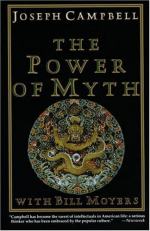
|
| Name: _________________________ | Period: ___________________ |
This test consists of 15 multiple choice questions and 5 short answer questions.
Multiple Choice Questions
1. Who were the first storytellers?
(a) Hunters
(b) Gatherers
(c) Farmers
(d) Hunter-gatherers
2. Which of the following is an intrinsic part of society's culture?
(a) Punishment
(b) Religion
(c) Rules
(d) Laws
3. From where did the clergy during medieval times indicate their authority was derived?
(a) Inescapable supernatural laws that rule over the natural world
(b) Sins of mankind
(c) God
(d) Their own meditations and personal contact with God
4. What does Black Elk see in his vision?
(a) Peace between the Sioux and the white man
(b) The birth of a great Sioux leader
(c) Tragic fate for his people
(d) The annihilation of the buffalo
5. With what do the invaders replace the temple to the Sun?
(a) Temple to the Moon
(b) Nothing, they left the temples intact
(c) Statue of Christ
(d) Catholic Cathedral
6. Which of the following is not one of the more sophisticated concepts of God?
(a) Giver of life
(b) Creator of the World
(c) Ultimate Lord of the Universe
(d) Supreme Being
7. Modern churches are built like what according to Campbell?
(a) Theatres
(b) Temples
(c) Skyscrapers
(d) Office buildings
8. Which of the following is not part of the notion of appeasement for taking the life of a wild creature according to Campbell?
(a) Prey returning to life
(b) Continuation of the cycle
(c) Food
(d) Cooperation
9. What is the best definition of a myth?
(a) Cultural norms
(b) Written history of mankind
(c) Society's unspoken rules
(d) Body of stories and legends
10. What is the architecture of a city an expression of in a society?
(a) Spiritual tenets
(b) Sacred places
(c) Spiritual powers
(d) Universal sanctification
11. What kind of powers did plains dwellers attribute to animals and plants?
(a) Personified powers
(b) Spiritual powers
(c) Healing powers
(d) Supernatural powers
12. In medieval times, what does Campbell indicate the clergy did to ordinary people?
(a) Controlled
(b) Listened
(c) Surprised
(d) Preached
13. Campbell indicates that it is possible for contradictory versions of a myth can exist in the _______ culture.
(a) same
(b) differing
(c) opposing
(d) alternate
14. When do dreams become a part of society's myths?
(a) When people share the dreams and metaphors from the dreams
(b) When there are specific actions or symbols in the dreams
(c) When they act out a known society's myth
(d) When dreams are interpreted by psychologists
15. What do the Navaho include in their sand paintings?
(a) White men
(b) Hogans
(c) Pipes
(d) Mythologized animals figures
Short Answer Questions
1. Which of the following is the best synonym for the term contradictory?
2. What does Campbell state about sacred places?
3. Which of the following is another name for Mexico City?
4. Which of the following could be considered a vestige of an earlier Hunter-Gatherer myth?
5. What is the end of the inward journey?
|
This section contains 508 words (approx. 2 pages at 300 words per page) |

|




